differential LEXUS LX470 2007 Owners Manual
[x] Cancel search | Manufacturer: LEXUS, Model Year: 2007, Model line: LX470, Model: LEXUS LX470 2007Pages: 426, PDF Size: 10.95 MB
Page 13 of 426

xiii
A
Trip information display P. 110
Clock P. 223
Outside temperature display
P. 224
Security indicator light
P. 47,49
Audio system
P. 183
AIRBAG ON and OFF
indicator
P. 67
Front passenger's
seat belt reminder
switch
P. 67,340
Air conditioning system P. 172
Outside rear view mirror
defogger switch
P. 182
Rear air conditioning switch P. 180
Emergency flashers
Center differential lock/
unlock switch
P. 139
Antenna switch
P. 193
Rear window defogger switch P. 182
Without navigation system
Page 14 of 426
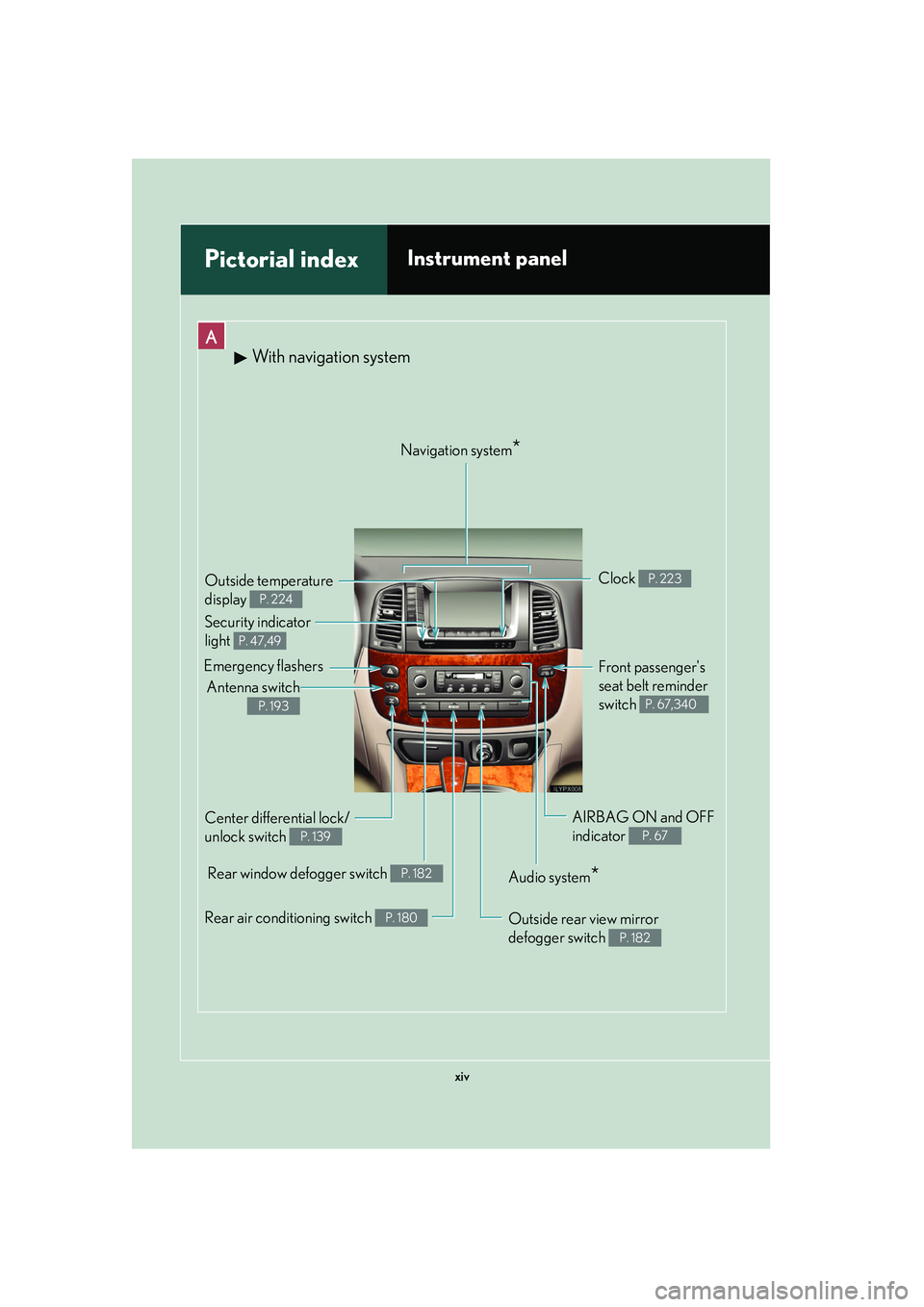
xiv
Pictorial indexInstrument panel
A
Rear air conditioning switch P. 180Outside rear view mirror
defogger switch
P. 182
Audio system*
Rear window defogger switch P. 182
Front passenger's
seat belt reminder
switch
P. 67,340
AIRBAG ON and OFF
indicator
P. 67
Clock P. 223Outside te
mperature
display
P. 224
Navigation system*
Center differential lock/
unlock switch
P. 139
Antenna switch
P. 193
Emergency flashers
Security indicator
light
P. 47,49
With navigation system
Page 126 of 426
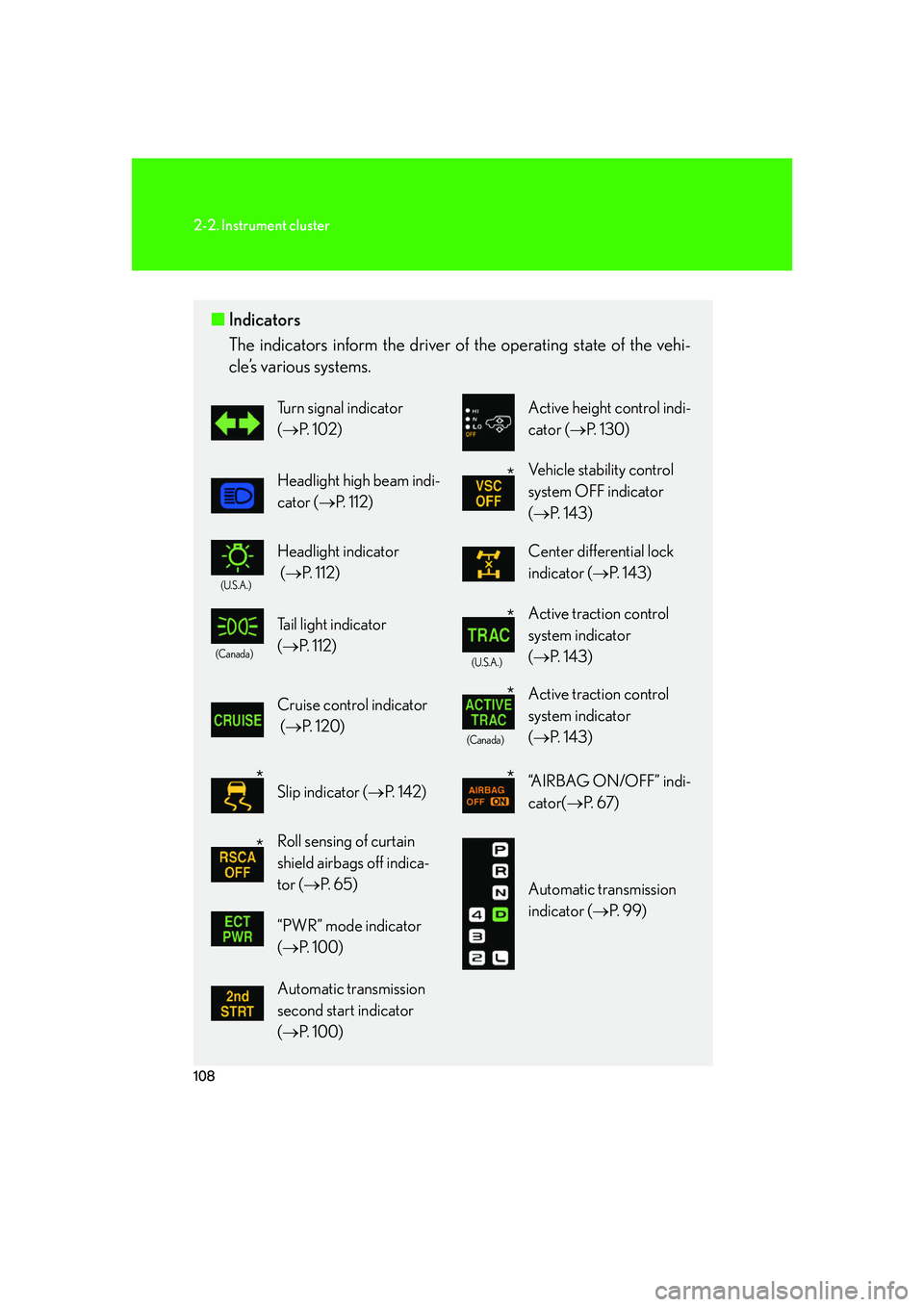
108
2-2. Instrument cluster
■Indicators
The indicators inform the driver of th e operating state of the vehi-
cle’s various systems.
Turn signal indicator
( P. 1 0 2 )Active height control indi-
cator ( P. 1 3 0 )
Headlight high beam indi-
cator (P. 112)Vehicle stability control
system OFF indicator
(P. 1 4 3 )
(U.S.A.)
Headlight indicator
( P. 112)Center differential lock
indicator ( P. 1 4 3 )
(Canada)
Tail light indicator
(P. 112)
(U.S.A.)
Active traction control
system indicator
(P. 1 4 3 )
Cruise control indicator
( P. 1 2 0 )
(Canada)
Active traction control
system indicator
( P. 1 4 3 )
Slip indicator ( P. 1 4 2 )“AIRBAG ON/OFF” indi-
cator( P. 6 7 )
Roll sensing of curtain
shield airbags off indica-
tor ( P. 6 5 )
Automatic transmission
indicator ( P. 99)
“PWR” mode indicator
( P. 1 0 0 )
Automatic transmission
second start indicator
(P. 1 0 0 )
*
*
*
**
*
Page 152 of 426

134
2-4. Using other driving systems
■If the vehicle height does not change
If the vehicle is loaded too heavily, or the undercarriage has come into contact with
the road surface, the vehicle height cannot be raised/lowered. In this case, the indi-
cator lights will change as follows:
●The current mode indicator light will turn off, and the target mode indicator light
will begin flashing.
●The target mode indicator light will turn off, and the original mode indicator light
will be lit once more. (The vehicle height does not change.)
■In the following cases AHC will not operate
●The brake pedal has been depressed for longer than 5 seconds while the vehi-
cle is stopped.
●The suspension fluid temperature is lower than -22°F (-30°C).
●Driving on bumpy roads which may cause the suspension to fully elongate.
●If the steering wheel is abruptly turned more than 3/4 of a revolution with the
center differential lock system activated.
■Cold weather operation
It may take longer for the vehicle height to change if the suspension fluid tempera-
ture drops below -5°F (-15°C).
AHC does not operate when the suspension fluid temperature drops below -22°F
(-30°C).
●In this case, the selected height mode indicator light will flash when the height
mode select switch is pressed, however the vehicle height will not change.
Once the engine has warmed the suspension fluid to within normal operating
limits, AHC will begin operating and the vehicle height will automatically
change to the selected mode.
●When the suspension fluid is around -22°F (-30°C), the vehicle height may not
be able to be raised, even if AHC is operating. In this case, push “ ▼” then “▲ ”
on the height mode select switch after further warming the engine to select the
desired vehicle height.
Page 157 of 426

139
2-4. Using other driving systems
2
When driving
Four-wheel drive system
■The four-wheel drive control lever can be operated when
●The shift lever is in the “N” position, and
●The vehicle is stopped completely.
Use the four-wheel drive control lever and center differential lock/unlock
switch to select following transfer and center differential modes.
Four-wheel drive control lever“H” (high speed position)
Normal driving on all types of
roads.
“N” (neutral position)
No power is delivered to the
wheels.
“L” (low speed position)
Driving requiring maximum
power and traction such as
climbing or descending steep
hills off-road driving and hard
pulling in sand or mud, etc.
Center differential lock/unlock switchLock the center differential
when your vehicle’s wheels get
stuck in a ditch or when you are
driving on a slippy or bumpy
surface.
After the wheels are out of the
ditch or off the slippy or bumpy
surface, unlock the center dif-
ferential.
Page 158 of 426
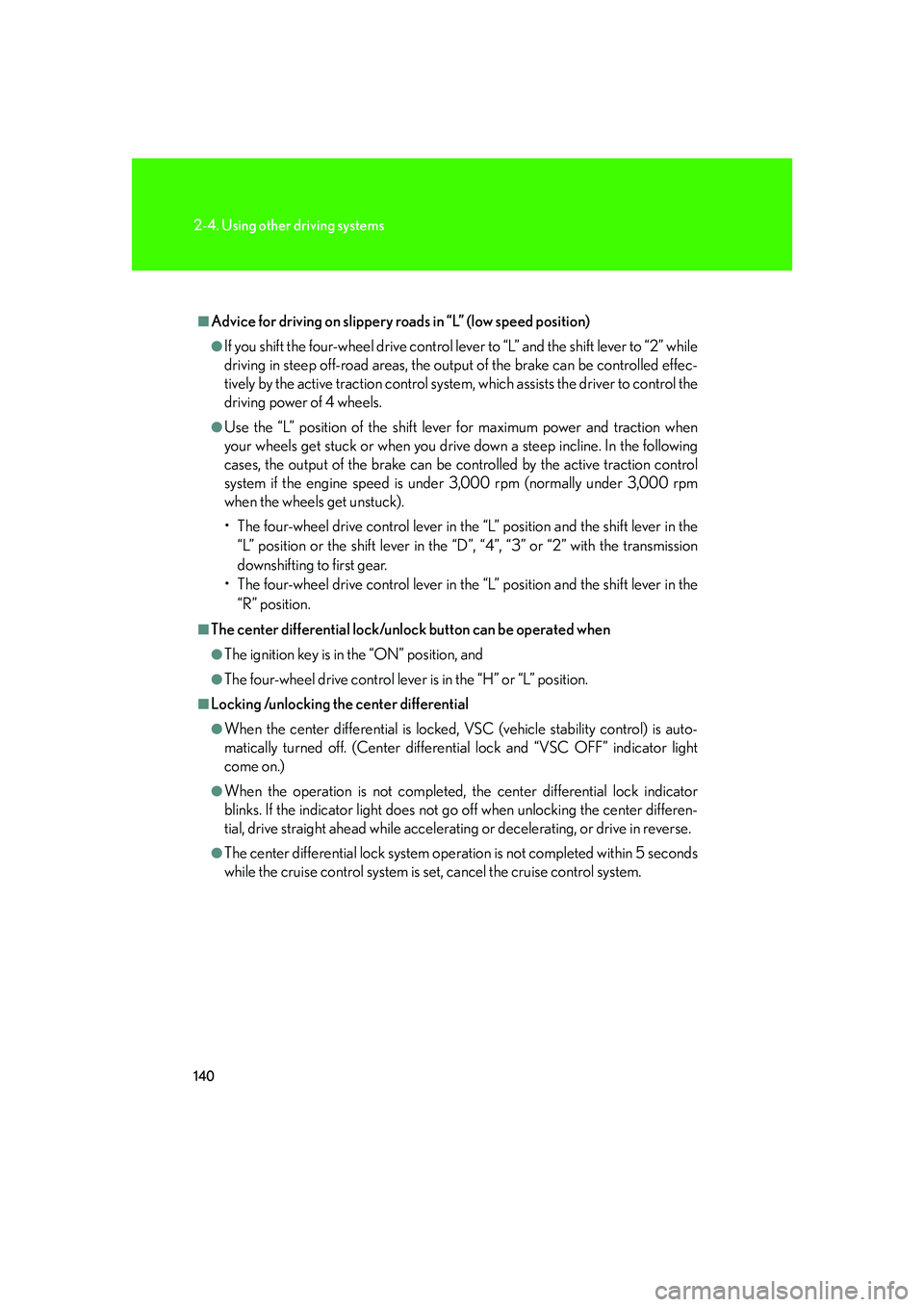
140
2-4. Using other driving systems
■Advice for driving on slippery roads in “L” (low speed position)
●If you shift the four-wheel drive control lever to “L” and the shift lever to “2” while
driving in steep off-road areas, the output of the brake can be controlled effec-
tively by the active traction control system, which assists the driver to control the
driving power of 4 wheels.
●Use the “L” position of the shift lever for maximum power and traction when
your wheels get stuck or when you drive down a steep incline. In the following
cases, the output of the brake can be co ntrolled by the active traction control
system if the engine speed is un der 3,000 rpm (normally under 3,000 rpm
when the wheels get unstuck).
• The four-wheel drive control lever in the “L” position and the shift lever in the
“L” position or the shift lever in the “D”, “4”, “3” or “2” with the transmission
downshifting to first gear.
• The four-wheel drive control lever in the “L” position and the shift lever in the
“R” position.
■The center differential lock/unlock button can be operated when
●The ignition key is in the “ON” position, and
●The four-wheel drive control lever is in the “H” or “L” position.
■Locking /unlocking the center differential
●When the center differential is locked, VSC (vehicle stability control) is auto-
matically turned off. (Center differenti al lock and “VSC OFF” indicator light
come on.)
●When the operation is not completed, th e center differential lock indicator
blinks. If the indicator light does not go off when unlocking the center differen-
tial, drive straight ahead while accelerating or decelerating, or drive in reverse.
●The center differential lock system operation is not completed within 5 seconds
while the cruise control system is set, cancel the cruise control system.
Page 159 of 426

141
2-4. Using other driving systems
2
When driving
CAUTION
■While driving
Never move the four-wheel drive control lever if the wheels are slipping. Doing so
may cause an accident resulting in death or serious injury.
NOTICE
■To prevent damage to the center differential
●For normal driving on dry and hard surface roads, unlock the center differential.
●Unlock the center differential after the wheels are out of the ditch or off the slip-
pery or bumpy surface.
●Do not push the center differential lock/unlock button when the vehicle is corner-
ing or when its wheels are spin ning freely off the ground.
Page 161 of 426

143
2-4. Using other driving systems
2
When driving
When the TRAC system is operatingIf the 4 wheels spin, the active trac-
tion control system indicator light
flashes to indicate that the TRAC
system have been engaged.
To disable VSC system
If the vehicle gets stuck in fresh snow or mud, VSC system may reduce
power from the engine to the wheels. You may need to turn the system off
to enable you to rock the vehicle in order to free it. Push the center differential lock/
unlock switch to turn off VSC sys-
tem.
The center differential lock and
“VSC OFF” indicator lights should
come on.
Push the switch again to turn the
system back on.
U.S.A
Canada
Page 167 of 426
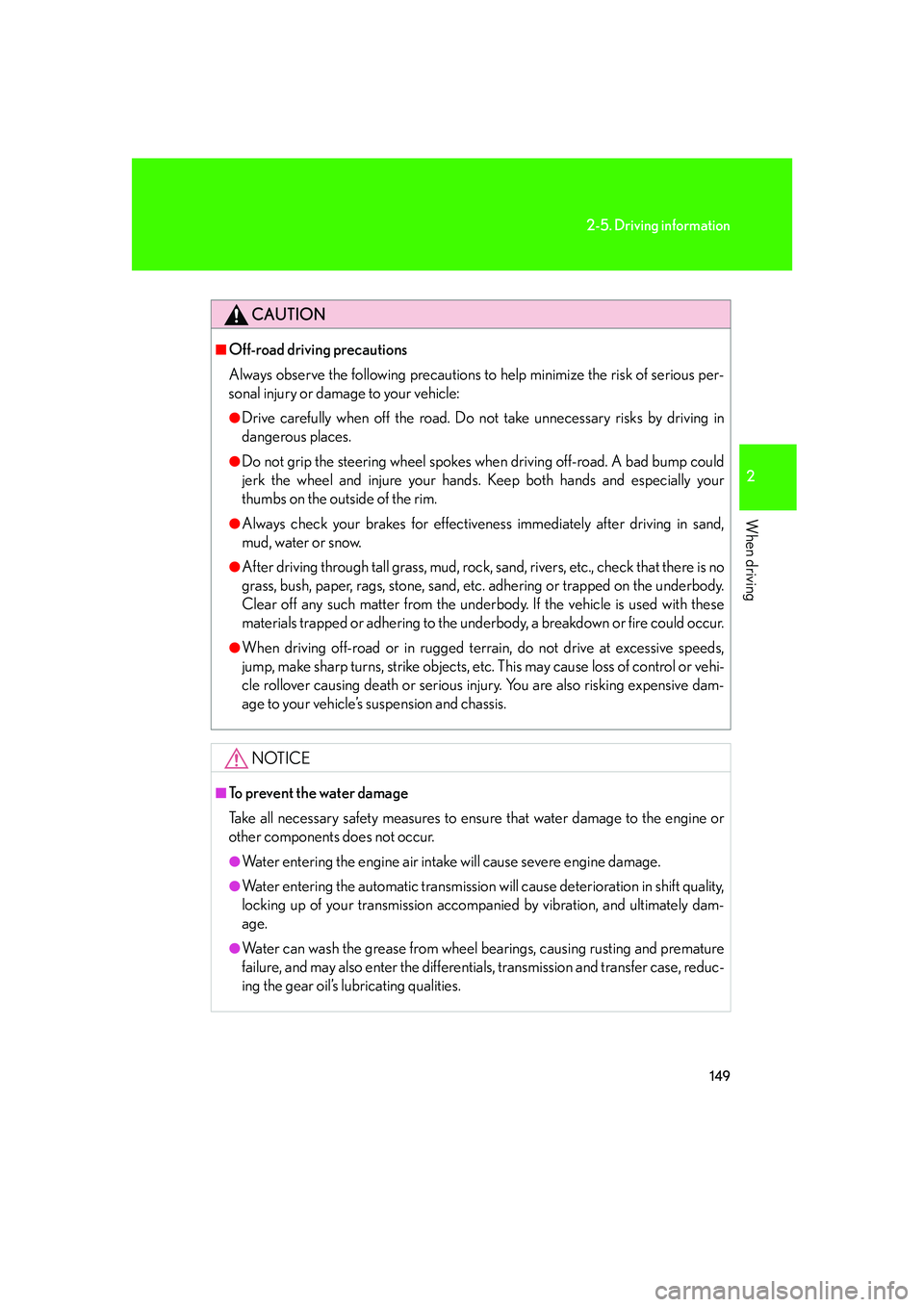
149
2-5. Driving information
2
When driving
CAUTION
■Off-road driving precautions
Always observe the following precautions to help minimize the risk of serious per-
sonal injury or damage to your vehicle:
●Drive carefully when off the road. Do not take unnecessary risks by driving in
dangerous places.
●Do not grip the steering wheel spokes wh en driving off-road. A bad bump could
jerk the wheel and injure your hands. Keep both hands and especially your
thumbs on the outside of the rim.
●Always check your brakes for effectiveness immediately after driving in sand,
mud, water or snow.
●After driving through tall grass, mud, rock, sand, rivers, etc., check that there is no
grass, bush, paper, rags, stone, sand, etc. adhering or trapped on the underbody.
Clear off any such matter from the underbody. If the vehicle is used with these
materials trapped or adhering to the underbody, a breakdown or fire could occur.
●When driving off-road or in rugged te rrain, do not drive at excessive speeds,
jump, make sharp turns, strike objects, etc. This may cause loss of control or vehi-
cle rollover causing death or serious injury. You are also risking expensive dam-
age to your vehicle’s suspension and chassis.
NOTICE
■To prevent the water damage
Take all necessary safety measures to ensure that water dama ge to the engine or
other components does not occur.
●Water entering the engine air intake will cause severe engine damage.
●Water entering the automatic transmission will cause deterioration in shift quality,
locking up of your transmission accompanied by vibration, and ultimately dam-
age.
●Water can wash the grease from wheel bearings, causing rusting and premature
failure, and may also enter the differentials, transmission and transfer case, reduc-
ing the gear oil’s lubricating qualities.
Page 182 of 426
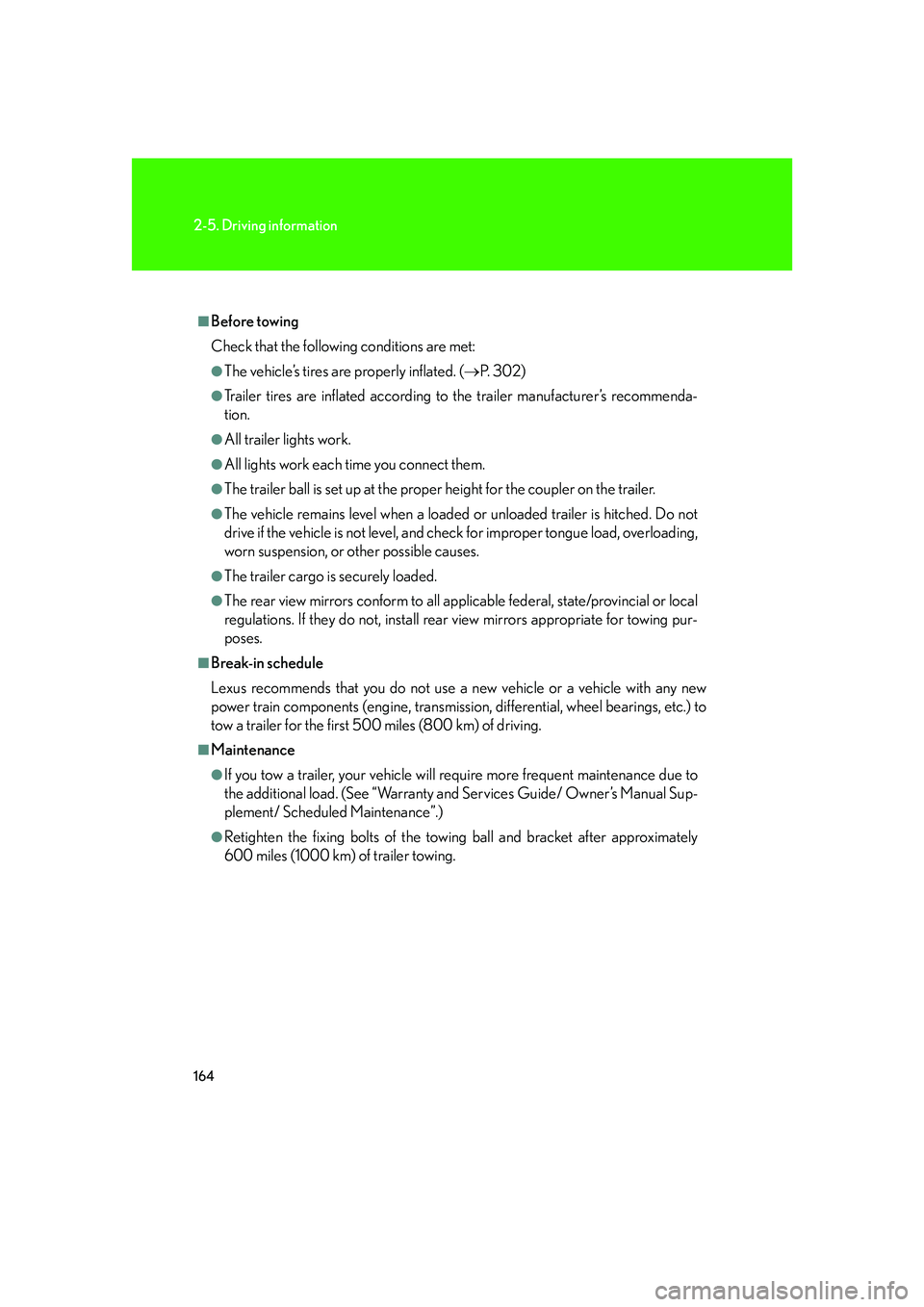
164
2-5. Driving information
■Before towing
Check that the following conditions are met:
●The vehicle’s tires are properly inflated. (P. 3 0 2 )
●Trailer tires are inflated according to the trailer manufacturer’s recommenda-
tion.
●All trailer lights work.
●All lights work each time you connect them.
●The trailer ball is set up at the proper height for the coupler on the trailer.
●The vehicle remains level when a loaded or unloaded trailer is hitched. Do not
drive if the vehicle is not level, and check for improper tongue load, overloading,
worn suspension, or other possible causes.
●The trailer cargo is securely loaded.
●The rear view mirrors conform to all applicable federal, state/provincial or local
regulations. If they do not, install rear view mirrors appropriate for towing pur-
poses.
■Break-in schedule
Lexus recommends that you do not use a new vehicle or a vehicle with any new
power train components (engine, transmission, differential, wheel bearings, etc.) to
tow a trailer for the first 500 miles (800 km) of driving.
■Maintenance
●If you tow a trailer, your vehicle will require more frequent maintenance due to
the additional load. (See “Warranty and Services Guide/ Owner’s Manual Sup-
plement/ Scheduled Maintenance”.)
●Retighten the fixing bolts of the towing ball and bracket after approximately
600 miles (1000 km) of trailer towing.